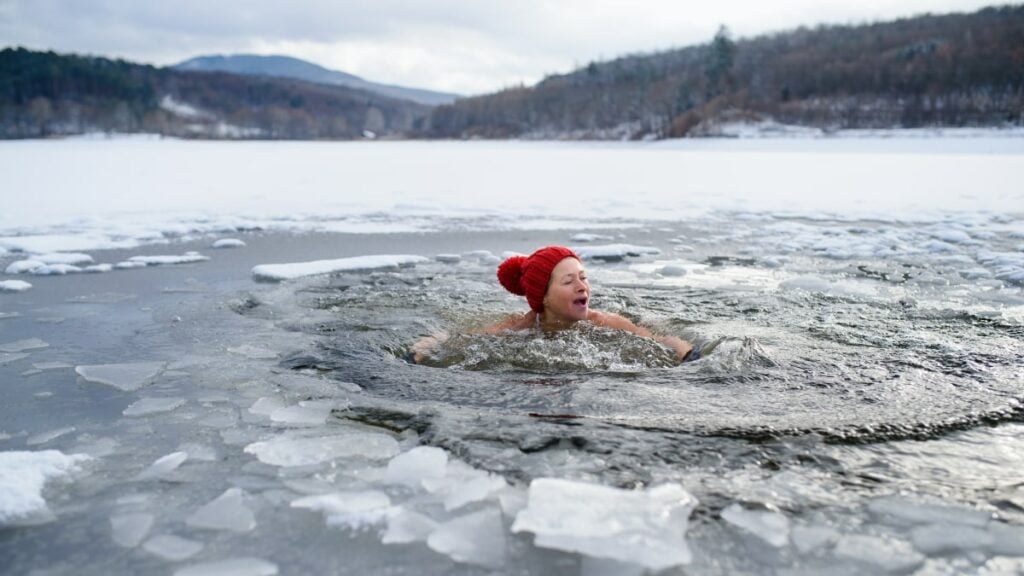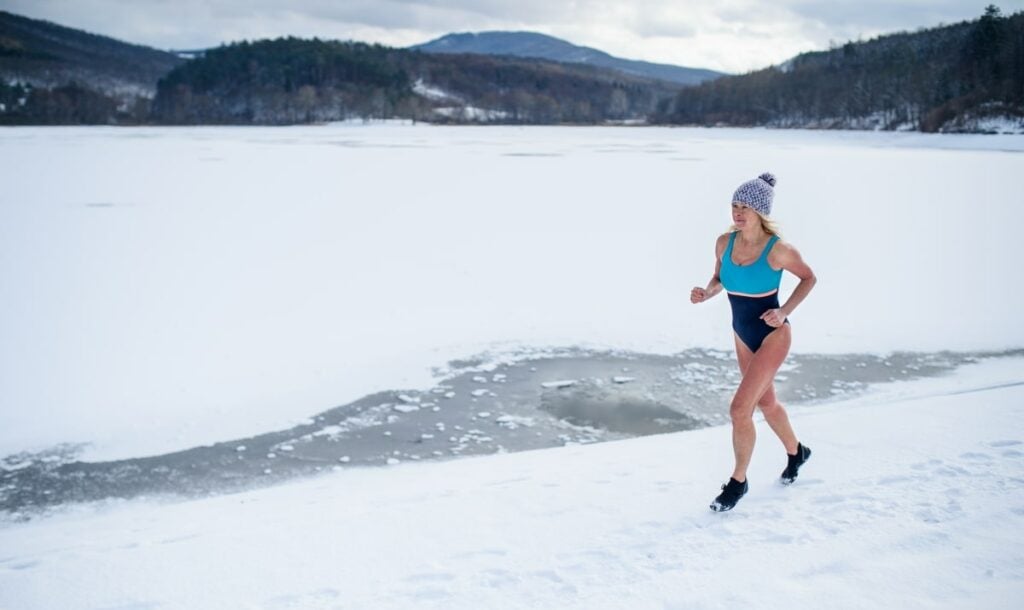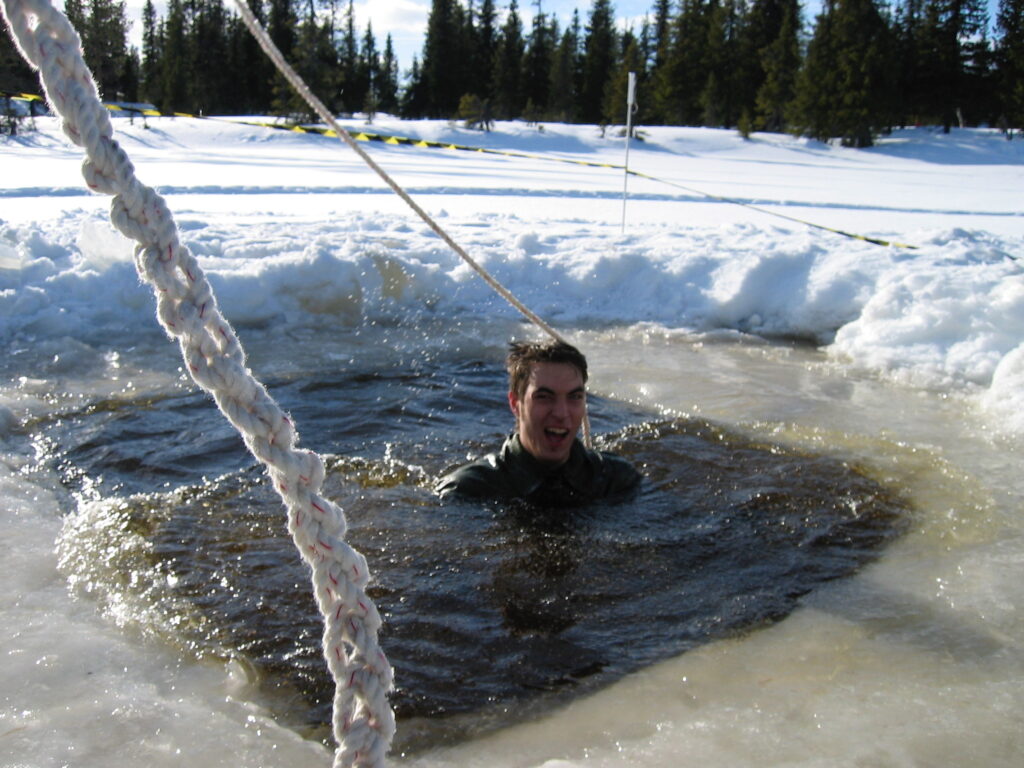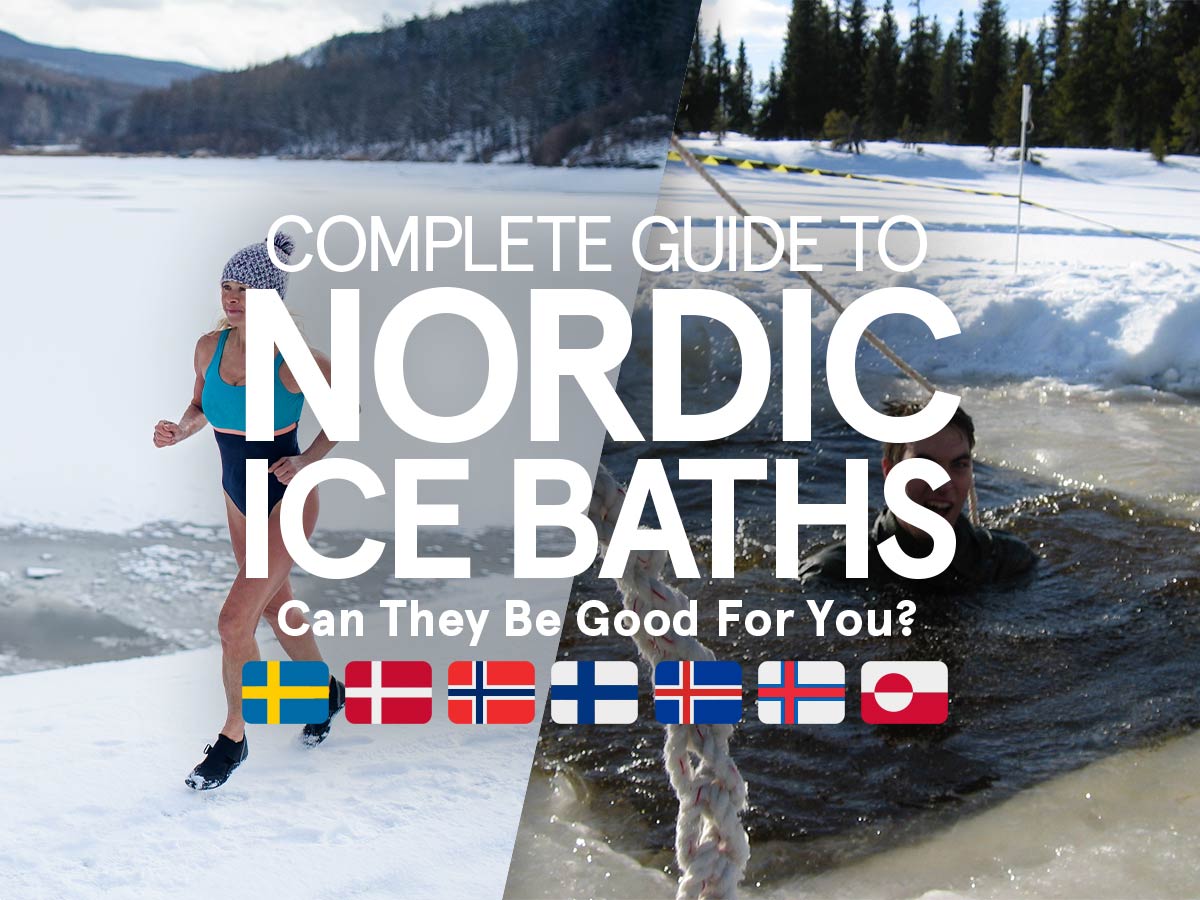We have been taking ice baths in the Nordics for a very long time, as it’s something that comes quite naturally when all the water around you is ice cold in the winter. And since the 1800s, very popular ice-bathing facilities can be found across the Nordic coastal regions, still widely used and growing in popularity still to this day.
So why not just heat up some bathwater instead of putting yourself through the ice-cold shock of a dip in the winter sea? Well, it turns out ice baths come with quite a few benefits for anyone brave enough to take the freezing plunge.
ℹ️ My Ice-Bathing Background
I’ve been taking ice-cold baths and jumped in the snow in connection with our Swedish-Finnish sauna routine since I was a kid, but it was during my Swedish Army winter training I started to learn about the real benefits this tradition has. We learned about ice-bathing from a scientific and physiological perspective, how it actually affects our bodies, and of course had the pleasure of being dunked in a frozen lake with full equipment (including skis) — because why not?
In the end, ice bathing is free for everyone, fairly uncomplicated, and it can give you a real energy boost when you need it the most. Afterward, you’ll feel unbeatable, energetic, light, and 100% alive. And you don’t have to pay a penny!
The list of health benefits of ice-bathing also seems to be getting longer every year, so I wanted to catch up on the latest science, verify the claimed benefits, and shed light on this ancient Nordic tradition. You’ll hopefully come out on the other end of this article knowing why we throw ourselves in ice-cold water, and why you probably should too!

Are Ice Baths Good For You?
Ice-baths can lead to a number of positive effects according to a Finnish study that followed 1000 ice-bathers for 4 months. In the study, they observed that Ice-bathing can:
- Strengthen your immune system by creating more white blood cells
- Produce a positive stress reaction and raises levels of serotonin and dopamine in your brain
- Function as a “vaccine” against stress, making you more resilient against negative stress
- Lower your blood pressure if you are going through a stressful phase of your life
- Enhance your blood circulation which leads to healthier arteries
- Produce more insulating brown (good) fat that replaces white (bad) fat
- Act as a pain killer when adrenalin and noradrenalin is released
- Produce an energy boost that makes you more alert in general
Here is how the ice-bathing Finns felt after having completed the study:
American professors Diwadkar and Muzik at Wayne State University reaches similar conclusions in their 2019 study, where they find evidence supporting that exposing your body to controlled stress can train your system to handle stress better, and experience a sort of high afterward (similar to a “runner’s high”).
They also emphasize how focusing on breathing calmly during an ice bath can yield similar results as meditation and yoga, helping you reach a sort of “flow” state.
Sports scientists are however still split whether or not ice-bathing should be used in connection with high-level physical activity (like for example footballer Christiano Ronaldo and basketball player LeBron James famously do after each game).
Still, there is no doubt that there are plenty of positive effects for us regular folks who happen to be pretty far from world-class athletes.
Can Ice Baths Be Bad For You?
When you submerge yourself in cold water you produce a stress reaction that immediately raises your blood pressure as the blood vessels shrink temporarily to adjust for the lower temperature. So if you have any form of heart condition ice bathing might not be advisable.
People with diabetes should probably also avoid the cold dips, as it can affect blood flow to extremities negatively in those cases.
In the end you should consult with a health professional if you have any doubts or questions, and I’ll also leave you with this advice from Dr. Farcy, one of the American Academy of Emergency Medicine’s board of directors:
If you’re healthy and sober, jumping in the cold water for just a minute or so is unlikely to have any ill effects, since the immersion won’t be long enough to affect your core body temperature
Dr. David Farcy, physician who serves on the American Academy of Emergency Medicine’s board of directors
Important Guidelines for Ice-Bathing (How-To Guide)
- Prepare gradually:
- Start getting used to the cold water gradually, preferably by starting in a bit warmer (but still cold) water in the spring or fall
- Warm up in the sauna beforehand if possible
- Stay safe:
- Don’t stay in the water for too long (5-20 seconds can be enough, 10 minutes absolute max)
- Don’t dip your head if you are a beginner
- Never ice-bath alone
- Do not ice-bath if you are suffering from heart problems or high blood pressure
- Keep the temperature just right:
- Aim for the water temperature in an ice bath to be between 2-10 ℃ (35.6-50 ℉)
- Wear something like a wool hat on your head if you’re keeping it above water
- Get warm gradually:
- Emerge from the water
- Dry your entire body
- Move around until you start feeling your limbs again
- Get into the sauna if you have access to one (If not, just put on a couple of light layers of clothes at this stage and stay indoors)
Bonus tip: Bath naked if possible to avoid getting even colder due to your wet swimwear.

A History of Nordic Ice Baths
Why do Nordic people take ice baths?
In the colder half of the year, ice-bathing has been a natural part of Nordic people’s daily life historically speaking. And in modern times, the ice-bathing trend has only been growing since the first Nordic ice-bathing facilities opened to the public in the 1800s.
So there really wasn’t much of a choice before the advent of electricity, if one would still like to wash on a regular basis in the winter (without wasting precious firewood to heat up the water every time). This likely led to ice-bathing being a natural part of many Nordic peoples’ lives, even up to this day.
How old is the tradition of ice baths in the Nordics?
The Nordic ice-bathing tradition possibly dates back to the Finnish stone age, when hearth pit saunas were commonly built and used in the winter. We know for sure that ice-bathing became a common activity among the masses in the 1800s, when the first ice-bathing facilities opened all around the Nordic region.
Quick Answers About Ice Baths
How Does it Feel to Take an Ice-Bath?
Here is how I would describe what happens in my body when I jump into ice-cold water (or snow):
- The Shock Stage – Most of my muscles feel like they are shutting down, but I still have no problem keeping myself afloat. If I jump into the water I usually experience shortness of breath for 10-20 seconds. It’s usually impossible to talk at this stage due to the shock.
- The Adaptive Stage – Your limbs start responding to your brain signals again, you can start breathing in a fairly normal manner again, and you start feeling how your whole body tingles with stimulation.
- The Cold Stage – This is when my body usually realizes exactly how cold the water is, and what will happen if I stay for too long. A mental countdown to get out of the water usually starts here.
- The Emerging Stage – Emerging from the ice-cold water brings on a whole new flood of sensations, the strongest of which usually becomes your need to warm up. You also feel more alive than you ever have at this stage, with a flood of adrenalin pumping through your body.
- The Warming Up Stage – The best way to warm up is gradually. Get dry, start moving around to get the blood flowing again (this won’t be an issue at this stage, trust me!), and once you start feeling normal again in your arms and legs you can enjoy a warm sauna if you have access to one (it’s ok without one too, as long as you are dry and put on some layers right away).

How often should you take ice baths?
Most studies done on the subject show that maximum health benefits are achieved by ice-bathing four to seven times a week. But doing it just once every once in a while can also yield a slew of positive effects, so you don’t have to go hardcore in order to benefit from the polar plunge.
Sources:
https://health.usnews.com/health-news/blogs/eat-run/articles/is-cold-water-swimming-good-for-me
https://www.nike.com/se/a/fordelarna-med-varma-och-kalla-bad
https://www.tandfonline.com/doi/abs/10.3402/ijch.v63i2.17700
https://capio.se/tips-och-rad/nya-vanor/vinterbada-smart-och-upplev-en-stund-i-nuet/
https://yle.fi/news/3-10581934
 Finnish vs. Swedish Sauna: 5 Differences According to Finns in Sweden
Finnish vs. Swedish Sauna: 5 Differences According to Finns in Sweden 17 Tips To Live a More Nordic Life
17 Tips To Live a More Nordic Life The Best Scandinavian Winter Boots for Everyday Use (2024)
The Best Scandinavian Winter Boots for Everyday Use (2024) Swedish Breakfast Habits: A Complete Guide
Swedish Breakfast Habits: A Complete Guide

